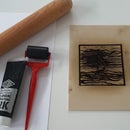Introduction: Spheremin What?
The theremin (originally known as the ætherphone/etherphone, thereminophone or termenvox/thereminvox) is an early electronic musical instrument controlled without physical contact by the thereminist (performer). It is named after the Westernized name of its Russian inventor, Léon Theremin, who patented the device in 1928.
The instrument's controlling section usually consists of two metal antennas that sense the relative position of the thereminist's hands and control oscillators for frequency with one hand, and amplitude (volume) with the other. The electric signals from the theremin are amplified and sent to a loudspeaker.
The present instructable uses a public available schematic created by Arthur Harrison and available here , but differ from that because it relays on commercial available power supplies and uses spherical antennas. Hence the name SPHEREMIN...
Step 1: Working Principle
Well... I'm not that expert in electronics, so if I have to trust wikipedia I'd say that "the theremin uses the heterodyne principle to generate an audio signal. The instrument's pitch circuitry includes two radio frequency oscillators set below 500 kHz to minimize radio interference. One oscillator operates at a fixed frequency. The frequency of the other oscillator is almost identical, and is controlled by the performer's distance from the pitch control antenna. The performer's hand acts as the grounded plate (the performer's body being the connection to ground) of a variable capacitor in an L-C (inductance-capacitance) circuit, which is part of the oscillator and determines its frequency."
To control volume, the performer's other hand acts as the grounded plate of another variable capacitor.
For a more detailed insight have a look at the Wikipedia page and theremin 126 page.
Step 2: Build It!
The circuit schematics, the relative part list as well as the detailed circuit assembly instructions are available at Art's Theremin website. Since I'm not building the power supply myself you don't need to get those parts.
The other parts you need:
- 13 cm stainless steel hollow spheres (2 pieces, ebay): you will need to drill an hole in them in order to fix them on the box. I used a dremel and drilled a keyhole shaped hole
- Mean Well RS-50-12, Switching Power Supplies 50.4W 12V 4.2A (1 piece, mouser electronics)
- Mean Well RS-75-48, Switching Power Supplies 76.8W 48V 1.6A (1 piece, mouser electronics)
- filtered socket with switch and fuse (mouser electronics or ebay)
- perforated plate to assembly the circuit (hardware store)
- wood, hinges and spring locks to build the box
- hearphones if you want to hear anything... :)
- external amplifier and loudspeaker if you want to annoy people a lot... :)
You will find a draft 3d model for the box in the attachment (Solidworks 2013 format).
Notes
Since the design is quite different from the "standard" theremin I had to modify a couple fo things in order to get the device to work properly. In detail
- volume fix: just removed C6
- pitch fix: added 10pF capacitance in parallel with C17
After setting C5 and C24 in the proper positions (about half way) everything worked fine. I hope is the same for you! :)
Attachments
Step 3: Safety Notices
The circuit described in this article uses AC mains voltage and other high voltages that can cause injury or death. It is the responsibility of the user of this circuit to be familiar with all applicable safety practices regarding its construction, testing, and use.
Some parts used in this circuit only function properly when inserted in the right direction. Always verify the orientation of polarized capacitors, diodes, rectifiers, transformers and vacuum tubes before applying power to them. Do not use a part that has been subjected to improper insertion.
The vacuum tubes in this circuit become hot and can cause burns.
Wear safety glasses and use all appropriate safety equipment when working with tools and materials. Always follow safe shop practices and obey safety rules.
Regarding the safety of your ears and hearing: do not play this instrument at a high volume, especially when using headphones. Use headphones that have a built-in volume control, and adjust the volume for a comfortable level. Hearing experts advise against the continuous, extended use of headphones.This circuit is recommended for users familiar with electronic theory and construction practices. It is recommended that suitable test equipment, including a frequency counter and oscilloscope, are available for making measurements.

Participated in the
Make Noise Challenge

Participated in the
Epilog Contest 8

Participated in the
Remix Contest 2016








![Tim's Mechanical Spider Leg [LU9685-20CU]](https://content.instructables.com/FFB/5R4I/LVKZ6G6R/FFB5R4ILVKZ6G6R.png?auto=webp&crop=1.2%3A1&frame=1&width=306)





